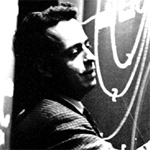A brightly coloured flower
As a member of CERN’s Education Services, Rafel Carreras gave highly acclaimed popular science lectures for over 30 years, explaining science ‘as it happened’ to the general public.
 “I took physics and biology at university with the aim of popularising these two branches of science, but I never imagined I would end up doing so at CERN. The unexpected does sometimes happen. I joined the Education Service as a ‘general' physicist in 1965. The team essentially amounted to Guy Vanderhaeghe and his secretary Madeleine Viader. In those days, many people working at CERN had to be jacks-of-all-trades — and we were no exception! In addition to organizing Academic Training, Technical Training and Language Training, mostly using staff members as teachers, we had to respond to all kinds of requests, some of them quite unexpected. One time I had to give a midnight lesson to the ‘scanners' who were conscientiously measuring the images taken in a bubble chamber and did not have the slightest notion of the physics they were helping to advance.
“I took physics and biology at university with the aim of popularising these two branches of science, but I never imagined I would end up doing so at CERN. The unexpected does sometimes happen. I joined the Education Service as a ‘general' physicist in 1965. The team essentially amounted to Guy Vanderhaeghe and his secretary Madeleine Viader. In those days, many people working at CERN had to be jacks-of-all-trades — and we were no exception! In addition to organizing Academic Training, Technical Training and Language Training, mostly using staff members as teachers, we had to respond to all kinds of requests, some of them quite unexpected. One time I had to give a midnight lesson to the ‘scanners' who were conscientiously measuring the images taken in a bubble chamber and did not have the slightest notion of the physics they were helping to advance.
This is the exact same spirit that guided me in the weekly ‘Science for all' lectures, which I gave for over 30 years, mainly for people without a scientific background. In these lectures I would explain and discuss the latest scientific developments. Once a month I also gave a major evening lecture ‘Science today' which attracted people from all over the region, come rain or shine. I used to cover about 20 subjects, from astrophysics to the human sciences, passing seamlessly from one to another.
I often had university professors in the audience, schoolchildren, pensioners, sometimes even a mother feeding her baby, not forgetting the former CERN staff member whose job in my early years had been to clean off the blackboards at the end of my lectures, who, after he had retired, used to attend my lectures and sit in the front row…
This incredible mix of people imposed two obligations on me that were difficult to fulfil simultaneously, namely to ensure that no-one got bored and at the same time to provide rigorously correct scientific information, as there was always a chance that someone in the audience would know more about the subjects I was presenting than I did.
On several occasions my ‘show’ was attended by eminent scientists, curious to see the methods I used. After one talk, Victor Weisskopf, then Director-General of CERN, told me that he hoped that, one day, he would be capable of filling the audience with as much enthusiasm as I did. To this I replied that he was like a great tree who wished it had a brightly-coloured flower on the end of one of its boughs, and that I was just such a flower … but without a tree!
My job description stated that my assignment was to “contribute to the intellectual health of the staff”. It would be pretentious for anybody to claim that he had fulfilled such a task to perfection. That I was permitted to give it my best shot, without restrictions or hindrances, is entirely thanks to the trust and freedom granted me by CERN, an Organization to which I owe an immense debt of gratitude.
I am so privileged to have been able to work in such conditions that sometimes I have to pinch myself to check it wasn’t some fantasy dreamed up by the bad schoolboy I was to compensate for my poor school results. And I imagine that I’ll wake up from this dream at any moment and be obliged to return to school and face the awful prospect of being tested on the lessons I haven’t learned. This was partly why, during my last CERN lecture in 1998, I asked for permission to take away with me the bucket and sponge that were used for cleaning the blackboard. Today this bucket is where I keep all the mail I receive and it reminds me of the amazing adventure I had at CERN and serves as material proof that I probably no longer am a schoolboy and that everything I have described actually happened.”

